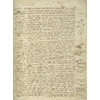Leonardo da Vinci photo gallery
Codex Leicester, 8v. - Page without illustrations, with observations geology, palaeontology and physical geography, preceded by a title: "Concerning the Deluge and fossil seashells". The presence of fossil seashells on the high mountains of Northern Italy, far from the sea, could not be attributed to the Biblical Flood, according to Leonardo. The seashells had lived in the sea and being "no faster in motion that snails out of the water, and even a bit slower" could not have travelled the 250 miles from the Adriatic Sea to Monferrato in the 40 days of the Biblical event. Furthermore, their weight kept them on the bottom, while Leonardo had found them on the mountaintops and in the lakes amidst the mountains, such as Lake Maggiore and Lake Como (and here he also mentions the lake of Fiesole and that of Perugia). Further on, as an example of the rivers that fall to the sea from a great height, he mentions the Arno at Golfolina, near Montelupo; he also describes the agglomerations of pebble and various stones, and the tufa rock as the "congealing of sand" at Castelfiorentino. Lastly, he recalls the fossil shells found "with various other marine things" in "bluish mud'", in the gorge cut by the Arno near Collegonzi (Vinci). The orderly arrangement of the layers of fossils shows that they had not been projected this far in the vortexes of the Biblical Flood (cf. ff. 9A - 9r, 9B - 9v, 10A - 10r, 10B - 10v).
Alessandro Vezzosi
Last update 14/mar/2008







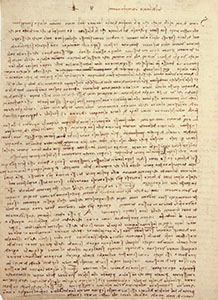


![Codex Atlanticus, 918r. - Study for a map of Tuscany (and adjacent areas), c. 1502. Hydrography in pencil, place names in pen and ink on paper. Codex Atlanticus, f. 910r. Surroundings of Castiglion Fiorentino (Aretino): "Montanina / Mammi / Chasstiglione aretino / a / b / c / to c is 1000 braccia / Cilone / road / Vingone / Renello / Monterchio / road [today SS 71] / road / road / 1380 braccia / 2024 braccia / Rucano / Chiane / road / 2208 braccia / 1472 braccia / 1704 braccia / f. Renello / f. Renello / 1104 braccia / road / the high 16 braccia / 1288 braccia / 650 braccia / Lock / [S]anto Antonio / Lake", c. 1502.](https://vitruvio.imss.fi.it/foto/isd/av/ca_0918r_100q.gif)
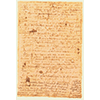
![Codex Atlanticus, 952r. - Study for the lake of San Lorenzo in Arniano near Vinci, c. 1504. The properties owned by "Giovanni Betti, Lazzero del Volpe, the Commune, and Ser Piero [Leonardo's father]" are indicated.](https://vitruvio.imss.fi.it/foto/isd/av/ca_0952r_100q.gif)
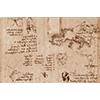
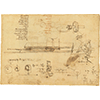


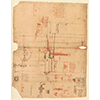




![Codex Leicester, 6v. - "Of ebb and flow" is the title of this page, which deals especially with the phenomenon of the tides. The folio concludes with a note on the diverse nature of the stone materials, progressively reduced in size, that, entrained downstream from the mountains, end up on the seabed: originally rocks, then pebbles and sand, and lastly "clay to make jugs with" (cf. ff. 6A - 31v e 18A - 19v). Writes Leonardo: "The river (Vin) [Vincio pistoiese? Cf. Madrid II, f. 23r], that flows down from the mountains, brings a great quantity of large stones in its riverbed, which stones still have some sharp corners and edges; and as it flows on, the stones it brings are smaller with the edges more consumed, that is, the big stones become smaller; and further on, it deposits large pebbles, and then smaller ones ..."](https://vitruvio.imss.fi.it/foto/isd/av/lei_06v_100q.gif)

![Codex Leicester, 9v. - Page with two drawings, which is dedicated, as stated already in the premise, to confuting the theories on fossil shells hypothesising that they had been transported far from the sea by the Biblical Flood Among his personal recollections, Leonardo mentions a "great sack" of fossil shells and corrals collected on the mountains around Parma and Piacenza by some peasants who had brought them to his "factory" where he was working on the "great Horse" for the Sforza. And then the timber found at Castelfiorentino ("in my time", that is, in his youth). In the margin of the folio he adds two experiments conducted in a "hole" with plates of glass at the sides: that of the deep wave and the wind [fig. 1]; and that of the surface wave. Interesting is the memorandum on making a terracotta shower: "Have it made here at the jug-maker".](https://vitruvio.imss.fi.it/foto/isd/av/lei_09v_100q.gif)
